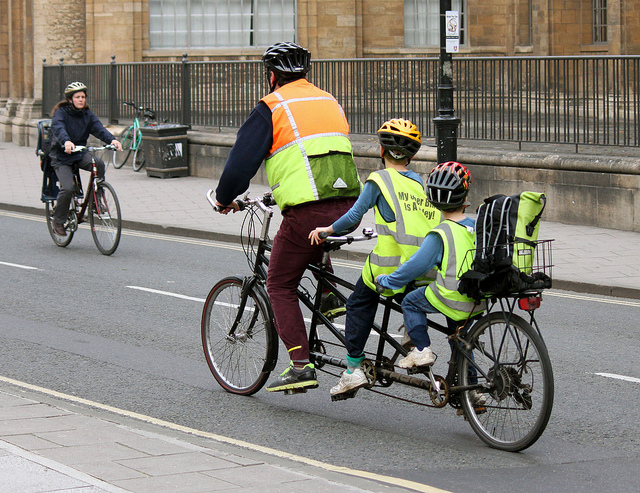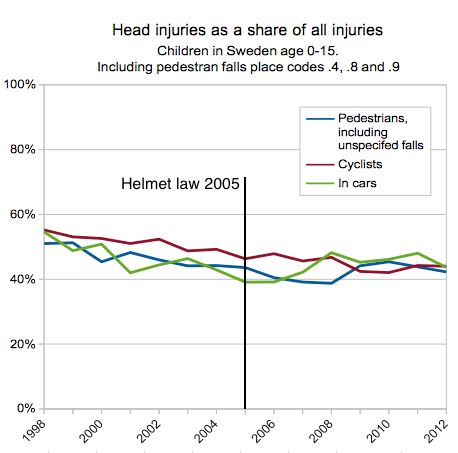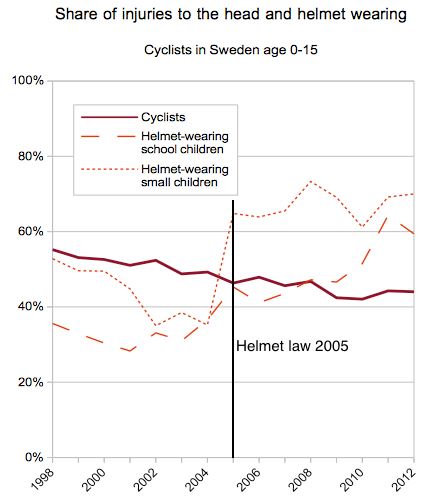
What happens when you mandate helmet-wearing among young Swedish cyclists?
In 2005 Sweden introduced a helmet law for cycling children. Mandatory helmet laws have been controversial in that they seem to have a limited effect on the number of head injuries, if at all, but instead are correlated with a decrease in cycling numbers. Guest writer Erik Sandblom takes a look at what the effect in Sweden was of the legislation on helmet wearing for Sweden’s young cyclists.
 Flickr/Tejvan Pettinger/used only as illustration
Flickr/Tejvan Pettinger/used only as illustration
One way to measure the effectiveness of helmets and helmet laws is to see whether head injuries fall faster than other injuries. And indeed this is the case; but as you can see from graph 1, pedestrians and car occupants get the same result. Therefore it is not necessarily helmets that are causing this slow decrease in head injuries since it also affects pedestrians and car occupants. This finding was recently published in Reflexen, the trade journal of the Swedish Association of Transportation Planners and confirms findings from other countries in peer-reviewed journals.
 Graph 1: Head injuries as a share of injuries to all parts of the body; pedestrians, cyclists and car occupants among the inspected.
Graph 1: Head injuries as a share of injuries to all parts of the body; pedestrians, cyclists and car occupants among the inspected.
Graph 1 shows the number of head injuries as a share of injuries to all parts of the body. The downward sloping lines indicate that head injuries are falling faster than other injuries. By measuring this way, we do not need to know whether cycling traffic is increasing or decreasing, which could be affecting the number of head injuries. Also we can then compare cyclists with other road users[1] to see if any reductions or increases are working only on cyclists, or are a result of an overall trend possibly including other road safety measures. As we can see there does not seem to be a difference between the trends of the different modes, suggesting that if there is any fall in the share of head injuries it is likely to be an effect of something that also applies to other or all road users.
Increased helmet use hasn't reduced injuries
The second graph looks at the percentage of helmeted cyclists and compares that with cyclists' head injuries as a share of overall injuries. It shows that the share of head injuries among cyclists (solid red line) remains on a slow downward trend as in the first graph, however the percentage of children wearing helmets (broken lines) jumps at the outset of the law in 2005. If an increase in helmet wearing were effective against head injuries we would expect a sharp fall in the share of head injuries to cyclists, mirroring the sharp increase in helmet wearing, and yet that does not appear to be the case. It's unclear exactly why increased helmet use hasn't reduced injuries; perhaps cycling accidents often happen at lower speed, which is slow enough for cyclists to throw up their hands reflexively, protecting their heads in an accident. It's also possible that cycle helmets are not soft enough to cushion the blow.
 Graph 2: Share of head injuries as a share of all injuries for child cyclists (solid red line) and helmet wearing amongst children (broken lines).
Graph 2: Share of head injuries as a share of all injuries for child cyclists (solid red line) and helmet wearing amongst children (broken lines).
Effect of helmet law: decline in cycling among school children
However there does seem to be another effect of helmet laws, namely a decline in cycling among school children. In 1983 57% of children aged 7-9 had permission from their parents to bike to school without adult companion, and for the age group 10-12, 94% had such permission. By the year 2007 this had decreased to 25% and 79% respectively. Bearing in mind, the helmet law was introduced in 2005, we can't be sure of a correlation, because the data consists of surveys from 1983 and then 2007. But we do also have data recording that the share of school journeys by bicycle fell from 33% in 2006 one year after the legislation to 29% in year 2012. The evidence does suggest that the effect of the helmet law primarily is that fewer children bike to school.
So the data does show a decline in cycling, but without annual surveys it's hard to be sure of a correlation. However, a Danish report[2] made the same link between declining cycling to school and helmet promotion and safety/scare campaigns. They determined that half the decline in cycling was caused by these campaigns, and half was caused by other factors such as more car traffic and longer distances to school.
The full article is in Swedish and is available for download from the website of the Swedish Association of Transportation Planners.
[2] En undersøgelse af børns trafiksikkerhed og transportvaner (PDF). Danmarks Transportforskning 2002.
About the author
 Erik Sandblom contributes to the environmental blog Ecoprofile.
Erik Sandblom contributes to the environmental blog Ecoprofile.
- Log in to post comments
Contact the author
Recent news!
Upcoming events
Contact Us
Avenue des Arts, 7-8
Postal address: Rue de la Charité, 22
1210 Brussels, Belgium









